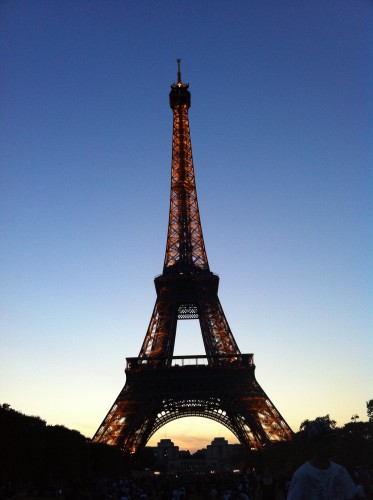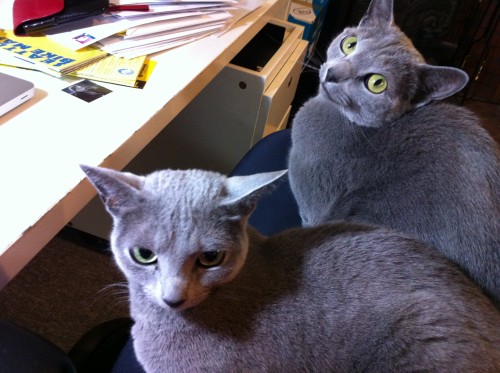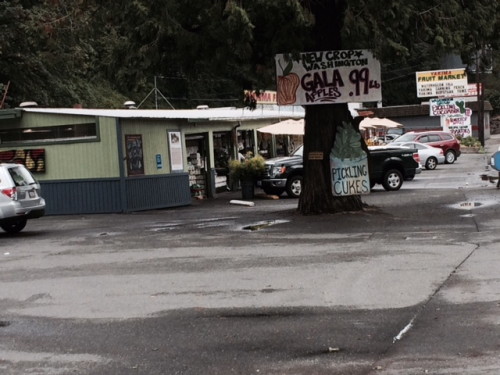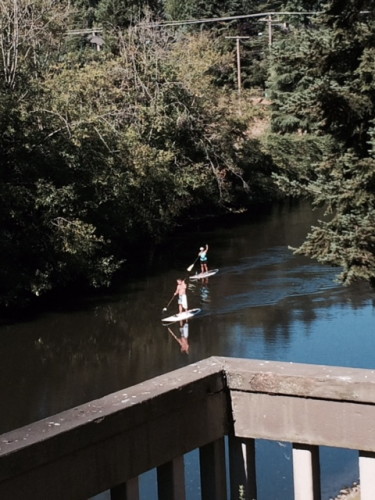I seem to be wearing a lot of gray lately. It’s not as if I’m a diluted Goth. Maybe it’s the weather. Then again, it may serve to hide the fur that our bums shed.
Permanent link to this article: http://ediblethoughts.com/2015/11/19/gray-is-the-new-black/
Nov 18
More Rainy-Day Haikus
What’s the deal with haikus, you ask? I think they’re a perfect poetry practice for scientific writers. One has to stuff maximum meaning in only seventeen syllables. Anyone who’s had to fit the results of a research project into a little box for a meeting abstract knows exactly what I mean. Monday was another rainy, traffic-clogged day on the bus, so it was time to write a few more haikus.
Welcome to Winter
Dark at 6 am.
Dark again at 4 pm.
The Sun? What is that?
Dead Giveaway
You can always tell
Folks just back from Hawaii:
Serious sunburns.
Too Much Time on My Hands
Killing time again.
Counting the cannabis shops
On Lake City Way.
And a more sober haiku:
There are many paths
To walk humbly with thy god.
Mass murder’s not one.
Permanent link to this article: http://ediblethoughts.com/2015/11/18/more-rainy-day-haikus-2/
Nov 14
The Joyride
[This is an adaptation of a story I told at my brother’s graveside service in 2006. November 15, 2015 would have been Lyle’s 55th birthday.]
Lyle was born with spina bifida. He got around in a wheelchair throughout his life; however, he was obsessed with motorized four-wheeled transportation. American muscle cars were his favorites. He took it upon himself to pass judgment on any car family members bought over the years. At least when it came to my cars, he was not complimentary.
In 1999, when we were living in Greensboro, NC, my partner Julian bought a Volkswagen GTI VR6. This was a limited-edition Golf with a 6-cylinder engine. Lyle was dismissive of this purchase. Never one to have someone disrespect his wheels, Julian plotted a way to show Lyle what his car’s capabilities were. He decided that we’d take the GTI home to New York for Thanksgiving and take Lyle on a joyride.
The day after Thanksgiving was marked for the ride. The weather was dry and sunny. We helped Lyle from the wheelchair to the car, I climbed in back, and Julian revved the engine. The early part of the drive was on back roads. Julian was relatively cautious on the curves. Then we got onto route 104, and Julian’s foot turned from feathery to leaden. The speedometer needle headed toward and above 90 mph. My eyes alternated between the speedometer and Lyle. The acceleration pushed him hard against the back of the seat, and his complexion was going from pale to red. Luckily, local law enforcement had not set up speed traps on the road that day. Once Julian decided that Lyle had had enough thrills, he slowed down and we turned back home.
The GTI rolled into Mom’s driveway. I pulled his wheelchair up to the passenger side of the car so Lyle could get out. Julian asked, “So what did you think?” Lyle’s characteristic response: “It runs.” This was the highest praise he could give.
Permanent link to this article: http://ediblethoughts.com/2015/11/14/the-joyride/
Nov 14
Nous Sommes Tous Parisiens
[Translated: We are all Parisians.]
Julian and I are both Francophiles. We love the language, culture, food, and country. It therefore broke my heart to hear about the terrorist attacks in Paris, to the east of the apartment where we stayed less than six months ago. My thoughts and prayers are with the people of this beautiful city.
Permanent link to this article: http://ediblethoughts.com/2015/11/14/nous-sommes-tous-parisiens/
Nov 12
The Montlake Mess
Examine a map of Seattle. It’s bounded on the east and west by water, and bisected by another body of water. As a result, bridges are choke points between A and B. One of the most congested bridges is next to the University of Washington campus, the Montlake Bridge. This bridge is a drawbridge, which snarls traffic at regular intervals during the summer. Immediately south of this bridge are exits from route 520, which includes a floating toll bridge over Lake Washington. As a result, I refer to this neighborhood as the Montlake Mess.
Several years ago I was transporting research samples between my hospital and the University of Washington (UW) Medical Center. To avoid parking charges, the lab manager at UW would meet me at the entrance driveway and I’d pass the samples out my window into his waiting hands. I’d call him about the time I approached the Montlake Mess so he could meet me. This worked reasonably well unless the bridge went up as I was driving down the hill.
This evening traffic at the Montlake Mess was at a standstill. Just south of the bridge there was a congregation of police cars. By the time I managed to get through (after a half hour of spewing nitrogen oxide gases from my Jetta “clean diesel”), things were more or less cleaned up. I don’t know what happened, but it took me at least half an hour to go three blocks. As a result, I could have ridden my bike home in about the time it took for me to drive home tonight. Such are the hazards of living hereabouts.
Permanent link to this article: http://ediblethoughts.com/2015/11/12/the-montlake-mess/
Nov 12
Asian Grocery Shopping
Over the years I’ve been lucky to find Asian groceries in the cities where I lived. They’ve helped expand my repertoire beyond throwing a can of water chestnuts into a pan of chicken and vegetables with some soy sauce and calling it Chinese cooking.The stores and their offerings have evolved over the years with the location and successive waves of immigrants.
When I first lived in Dallas, there was an Asian grocery around the corner from my apartment complex. It dealt mostly with Chinese, Japanese, and Korean products. I don’t recall seeing any kimchi there, although I wasn’t adventurous enough back then to look for or buy it. By the time I moved back to Dallas in 1992, the store had disappeared. I think the building was razed to make way for the Cathedral of Hope church – or at least its parking lot.
Greensboro, North Carolina is a hotbed of Southeast Asian cuisine in the Southeast. Many Vietnamese and Cambodian immigrant families were sponsored by various local churches and charities, particularly members of the Montagnard ethnic group. Our default dining option in town was Saigon Cuisine, which actually made the Saveur magazine 100 around 2001. I recall one rather large grocery store where I was able to find all the herbs I needed for bun bo Hue, my favorite Vietnamese soup. I also frequented a tiny shop run by a friendly Cambodian woman who always offered interesting samples.
Here in the Seattle area we have a plethora of Asian supermarkets to rival some of the Anglo chains in size. A brief rundown:
Uwajimaya. This is the 800-pound gorilla of Asian groceries in town. The mother ship is in the International District of Seattle, and smaller branches are located in Bellevue and Renton. It offers a diverse spread, but its roots are Japanese. It’s a little thin on Southeast Asian products and herbs, but there are other options for those nearby.
Viet Wah is predominantly Southeast Asian. It’s up the hill from Uwajimaya, in the Little Saigon neighborhood. It has other branches in the south end of Seattle. You want tapioca starch noodles and sawtooth herb, they’re there. There’s also a small grocery in the same plaza as Viet Wah, next door to the Tamarind Tree restaurant. We’ll duck into the smaller grocery for provisions if we’re eating at Tamarind Tree.
HT Market took over what used to be Larry’s on North Aurora Avenue. It tilts Southeast Asian; however, it has the standard Chinese barbecue pork and whole roast duck deli.
99 Ranch is a West Coast pan-Asian chain that has branches in Renton and Edmonds.
We ran across HMart in Bellevue last Saturday. It definitely skews Japanese and Korean.
There are several Indian groceries on the Bothell-Everett Highway and at Crossroads Mall and in the Overlake neighborhoods of Bellevue. Mayuri is one of the stores.
Seafood City is a large supermarket at Southcenter Mall that carries primarily Filipino food. In the north end, you’ll find small groceries such as Manila Manila in Lake City and Fil Am in Shoreline.
Walking into an Asian grocery can be a daunting experience for someone who thinks broccoli is an exotic vegetable. Even for people with a bit of knowledge of the assorted cuisines, it can be confusing. My advice is to start modestly with items that at least look familiar. For example, buy a bunch of Chinese broccoli and experiment; alternately, buy a bag of frozen potstickers. Take along a friend who has some experience. Try some of the samples. (I nearly passed out when my sister, who dislikes most Asian food, took a sample of a bun stuffed with bean paste at Uwajimaya and said it wasn’t bad.) Julian and I will purchase “experiment foods” at Uwajimaya. Some of them are very good; others don’t get bought again. Don’t be afraid to ask the store staff for recommendations, especially when you’re facing a shelf of 50 different brands of fish sauce.She or he will be able to steer you toward items that match your needs.
Permanent link to this article: http://ediblethoughts.com/2015/11/12/asian-grocery-shopping/
Nov 07
The Infamous Eggnog Bread Recipe
“Christmas Creep”, the phenomenon of getting Christmas-themed products into stores earlier and earlier each year, is getting out of hand. We saw eggnog in a neighborhood grocery store before Halloween this year. This example has its upside, however. You can start making eggnog bread now and freeze it for gifts in December.
Eggnog bread is the anti-fruitcake. I don’t use artificially-colored candied fruit or peel, although the original recipe (from Southern Living magazine, published in December 1983) called for it. You don’t have to make the recipe months in advance, soak it with booze, and store it wrapped in cheesecloth until you foist it on unsuspecting relatives, friends, and coworkers. The lack of alcohol makes it an appropriate gift for folks who don’t imbibe. Finally, it’s edible! Your aforementioned relatives, friends, and coworkers will love it. So here’s the recipe:
Infamous Eggnog Bread
2 ¼ cups all-purpose flour
2 teaspoons baking powder
1 teaspoon salt
2 eggs
¾ cup sugar
¼ cup vegetable oil
1 cup commercial eggnog (low-fat is fine)
1 cup of a mixture of dried fruit: raisins, dried cranberries, figs, dates, snipped dried apricots, or dried cherries
½ cup chopped pecans (walnuts or almonds can also be used)
Combine flour, baking powder, and salt; set aside.
Combine eggs, sugar, and butter in a large mixing bowl; beat well. Add flour mixture alternately with eggnog, beginning and ending with flour mixture. Stir in fruit and nuts.
Pour batter into a greased and floured 8 ½” x 4 ½” x 3” loaf pan or a Bundt pan. Bake at 350° 1 hour and 10 minutes (shorter for a Bundt pan) or until a wooden pick inserted in center comes out clean. Cool in pan 10 minutes; remove from pan and cool completely on wire rack. Yield: 1 loaf.
Notes:
- If you have relatives, friends, and coworkers who don’t do nuts, just increase the amount of fruit accordingly.
- The recipe can be doubled easily, but tripling is a bit much. If I’m in baking frenzy mode, I’ll make two separate batches.
Permanent link to this article: http://ediblethoughts.com/2015/11/07/the-infamous-eggnog-bread-recipe/
Nov 04
The Returns are Coming In
Washington has some quirks to its election system. First, we have a top-two primary. You can vote for anyone regardless of party affiliation. Two Democrats or two Republicans may face off in the general election. Then there are some races where someone from the fringes manages to make it out of the primary. Second, all voting is done by mail. People return their ballots via mail or at official drop boxes. The ballots need to be postmarked by Election Day to be counted. We won’t have the official results until later in the month; however, some results are clear from the first two batches of counted ballots. As examples:
The three candidates for the Bothell City Council who are not in the clutches of developers are all leading by wide margins. As the mayor is selected by the City Council from its ranks, the current mayor is probably not going to serve another term.
A perennial single-issue candidate is about 70 percentage points behind his opponent in a Port Commission race.
The city of Aberdeen, better known as the hometown of grunge rock idol Kurt Cobain, elected a 23-year-old as its mayor.
The town of Fircrest, the last dry town in Washington, overwhelmingly voted to allow restaurants to serve alcoholic beverages.
The Secretary of State’s office will release more vote totals daily until all of the votes are counted. Tight races at that point will go to recounts. Reversals of fortune in the above races are unlikely, but stranger things have happened. Stay tuned.
Permanent link to this article: http://ediblethoughts.com/2015/11/04/the-returns-are-coming-in/
Nov 01
End of the Season
I’m not talking about the World Series. The Yakima Fruit Market is wrapping up its season of selling fruits, vegetables, plants, pumpkins, and assorted groceries to Bothell residents. They’ll reopen after Thanksgiving, but just for Christmas trees and holiday greenery. Yesterday I went over to pick up a mess of produce, including the apples for the aforementioned applesauce. We’ll just have to content ourselves with supermarket produce until March 2, when Yakima reopens.
Permanent link to this article: http://ediblethoughts.com/2015/11/01/end-of-the-season/
Nov 01
Beautiful Downtown Bothell
We moved to Bothell from Seattle almost three years ago. My first experience of our fair city was when I wrote grants for a now-defunct biotech start-up our first year in Washington. I fell in love with the quaint downtown and the Yakima Fruit Market. The latter reminds me of the fruit stands near my hometown in New York.
Bothell’s about 10 miles northeast of downtown Seattle as the crow flies. Unfortunately, we humans have to drive here via either Lake City/Bothell Way or Routes 520 and 405. Route 520 necessitates going over a toll bridge and 405 is consistently congested, so cheapskates clog up the other route. There are days when paving over Lake Washington seems like a good idea. However, the destination is worth the trip.
Downtown Bothell is bordered to the south by wetlands and the Sammamish River. Even though the Sammamish is technically a slough, it gets a lot of traffic from kayaks, canoes, and paddle-boarders.
A couple of parks and two bike/hike trails also abut the river. Two colleges occupy the eastern edge of downtown, the University of Washington Bothell campus and Cascadia College, part of the community college system. The biotech ghetto is in the northern part of town, along with a series of strip malls. Some of the stores have a distinctive East Indian flavor, courtesy of the large number of immigrants who call Bothell home. Also north of downtown is Country Village, a shopping center that features a large wrought-iron rooster sculpture in front. We consider it the most significant landmark in town. (Seattle has the Space Needle, Bothell has the chicken.)
While Bothell’s restaurant scene is under development, we do have several good to excellent eateries in town. Pen Thai is a branch of a Thai restaurant in Bellevue, and serves outstanding food. Earlier this year we discovered Korea House, in the northern part of town. They make their own kim chi, and their soup broths are umami bombs. The McMenamins Anderson School complex opened last month and added at least three restaurants to the downtown area. It also boasts an indoor salt-water pool that’s free for Bothell residents. The best thing about Bothell restaurants: On most Friday or Saturday nights you don’t need reservations. There are few good restaurants in Seattle that can make that claim.
Is our fair city perfect? No. Some decisions of the Planning Commission and City Council tilt too far in the direction of developers. For example, who decided that the best first impression of town coming from the west would be a hilltop self-storage place that looks like a Medieval Times fortress? The clincher was the brouhaha over the golf course near our condo complex. The owners wanted to sell and get the property rezoned to accommodate mass quantities of townhomes and houses. The only way we found out was a rezoning sign that mysteriously appeared one Friday night last December. The back nine of the course was almost sold to a development group that included the mayor, and he did not disclose his involvement in the deal until late in the game. While this didn’t meet the “legal” standard of conflict of interest, the impression was not good. Fortunately, the upcoming election may change city operations for the better. Two of the pro-development council members are not running, and the one member running for re-election has been helpful in the fight against developing the golf course. Stay tuned for election results.
Permanent link to this article: http://ediblethoughts.com/2015/11/01/beautiful-downtown-bothell/




Recent Comments